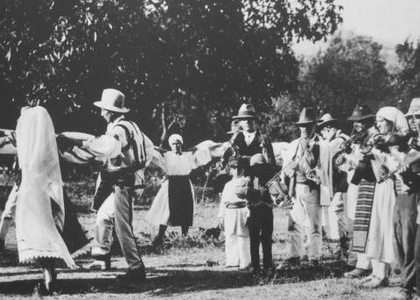> [Archived] Recommendations

To the Village's Hora (III); Folkloric Dances from Oltenia and Muntenia - Traditional Music, 8th February, 2015
We will listen to a few representative works of the Subcarphatian region of Muntenia, Dâmbovița, but also Oltenia and Gorj, Romanian lands which pride on with a robust and effervescent traditional music world. Also, we will outline a few distinctive thematic guidelines, the unity present in the diversity of the melodies, the stylistic and areal classification of the musical and choreographic music tempi of the traditional Romanian cultural space, elements which comprise, in a brief systematization, three main dialectal styles: the Carphatian, Danubian and Occidental one.
Brâul, Hora and Sârba are archetypal dance models of the Carphatic and Danubian styles. Brâul was placed in the Carphatic choreographic style category and described as some of the most prevalent and old Romanian folkloric dances. The generic title of the dance often has semantic completions, which specify its melodic-rhythmic structure and its number of steps: Brâul pe șase, pe șapte, pe opt or even pe nouă, Brâul bătrân or Brâulețul.
Hora is one of the most known, appreciated and danced Romanian folkloric dance, which has the occurrence area outlined especially in Muntenia and Oltenia, but the Romanians on the right shore of the Danube, and from Bulgaria and Serbia, and even from the Balkans dance it too. Having an immemorial, a Greek etymology and a circle dancing style, the Romanian hora dances can dress several traditional clothing: there are hore mari and hore mici, hore bătrânești andhore de mână, hore drepte, hore în două părți, hore boierești and many other categories.
Musical instruments of the oldest and simplest kind, such as the whistle and bagpipe were once enough to make the village's hora spin. Also, the violin and kobsa, accompanied sometimes by a small dulcimer and a contrabass, formed the traditional instrumental structure of the folk bands from Muntenia and Oltenia.
Thus, I invite you to discover together the fascinating universe of the Romanian oral culture on Sunday, 8th February, 2015, starting at 19:00, only here, during the Traditional Music programme.
Translated by Izabela - Elvira Vațe, and Elena Daniela Radu
MTTLC, The University of Bucharest














